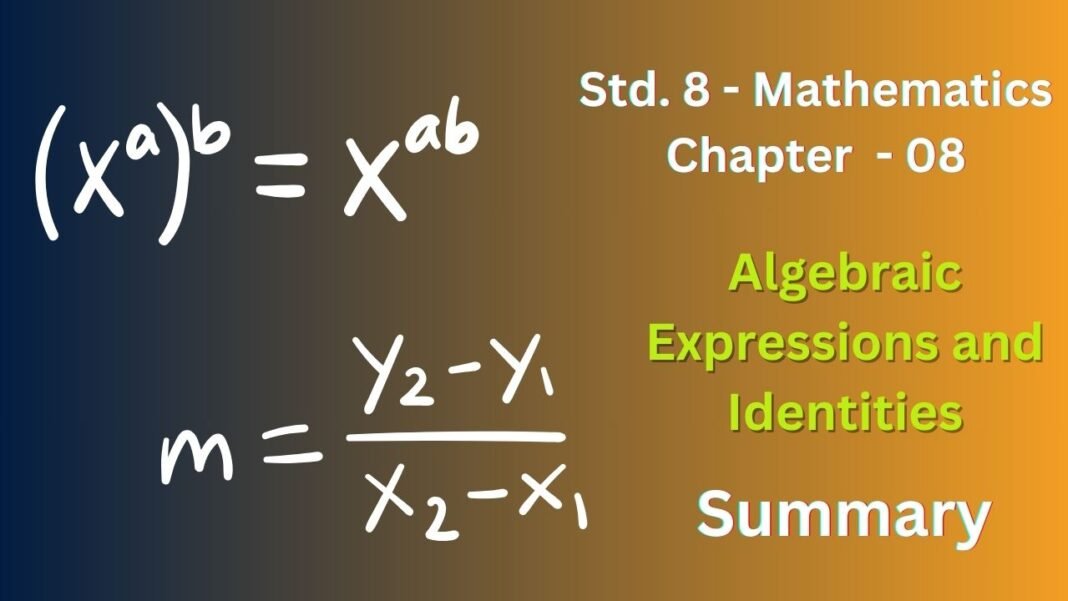This chapter introduces the fundamental concepts of algebra.
Key Topics:
- Algebraic Expressions: Combinations of variables (like x, y, z) and constants (like 2, -5) connected by mathematical operations (addition, subtraction, multiplication, division).
- Terms: Individual components of an algebraic expression separated by + or – signs.
- Factors: Numbers or variables multiplied together to form a term.
- Coefficients: Numerical factors of a term.
- Like and Unlike Terms: Terms with the same or different literal factors.
- Monomials, Binomials, Trinomials, and Polynomials: Classifications based on the number of terms.
- Addition and Subtraction of Algebraic Expressions: Combining like terms.
- Multiplication of Algebraic Expressions: Using the distributive law.
- Identities: Equations that hold true for all values of the variables involved. Common identities include:
- (a + b)² = a² + 2ab + b²
- (a – b)² = a² – 2ab + b²
- (a + b)(a – b) = a² – b²
Exercise 8.1
1. Add the following:
(i) ab – bc, bc – ca, ca – ab
(ii) a – b + ab, b – c + bc, c – a + ac
(iii) 2p2q2 – 3pq + 4, 5 + 7pq – 3p2q2
(iv) l2 + m2, m2 + n2, n2 + l2, 2lm + 2mn + 2nl
Ans :
Let’s add the algebraic expressions:
(i)
Adding the like terms, we get:
- ab – bc + bc – ca + ca – ab
- = 0
(ii)
Combining like terms:
- a – b + ab + b – c + bc + c – a + ac
- = ab + bc + ac
(iii)
Combining like terms:
- 2p²q² – 3pq + 4 + 5 + 7pq – 3p²q²
- = -p²q² + 4pq + 9
(iv) l² + m², m² + n², n² + l², 2lm + 2mn + 2nl
Combining like terms:
- l² + m² + m² + n² + n² + l² + 2lm + 2mn + 2nl
- = 2l² + 2m² + 2n² + 2lm + 2mn + 2nl
- = 2(l² + m² + n² + lm + mn + nl)
2. (a) Subtract 4a – 7ab + 3b + 12 from 12a – 9ab + 5b – 3
(b) Subtract 3xy + 5yz – 7zx from 5xy – 2yz – 2zx + 10xyz
(c) Subtract 4p 2q – 3pq + 5pq2 – 8p + 7q – 10 from 18 – 3p – 11q + 5pq – 2pq2 + 5p 2q
Ans :
(a) Subtract 4a – 7ab + 3b + 12 from 12a – 9ab + 5b – 3
- We change the signs of the terms in the expression being subtracted and then combine like terms.
- (12a – 9ab + 5b – 3) – (4a – 7ab + 3b + 12)
- = 12a – 9ab + 5b – 3 – 4a + 7ab – 3b – 12
- = (12a – 4a) + (-9ab + 7ab) + (5b – 3b) + (-3 – 12)
- = 8a – 2ab + 2b – 15
(b) Subtract 3xy + 5yz – 7zx from 5xy – 2yz – 2zx + 10xyz
- Following the same process:
- (5xy – 2yz – 2zx + 10xyz) – (3xy + 5yz – 7zx)
- = 5xy – 2yz – 2zx + 10xyz – 3xy – 5yz + 7zx
- = (5xy – 3xy) + (-2yz – 5yz) + (-2zx + 7zx) + 10xyz
- = 2xy – 7yz + 5zx + 10xyz
(c) Subtract 4p²q – 3pq + 5pq² – 8p + 7q – 10 from 18 – 3p – 11q + 5pq – 2pq² + 5p²q
- Similarly:
- (18 – 3p – 11q + 5pq – 2pq² + 5p²q) – (4p²q – 3pq + 5pq² – 8p + 7q – 10)
- = 18 – 3p – 11q + 5pq – 2pq² + 5p²q – 4p²q + 3pq – 5pq² + 8p – 7q + 10
- = (18 + 10) + (-3p + 8p) + (-11q – 7q) + (5p/1qq + 3pq) + (-2pq² – 5pq²) + (5p²q – 4p²q)
- = 28 + 5p – 18q + 8pq – 7pq² + p²q
Exercise 8.2
1. Find the product of the following pairs of monomials.
(i) 4, 7p
(ii) -4p, 7p
(iii) -4p, 7pq
(iv) 4p3, -3p
(v) 4p, 0
Ans :
(i) 4, 7p
- Product = 4 * 7p = 28p
(ii) -4p, 7p
- Product = (-4p) * (7p) = -28p²
(iii) -4p, 7pq
- Product = (-4p) * (7pq) = -28p²q
(iv) 4p³, -3p
- Product = (4p³) * (-3p) = -12p⁴
(v) 4p, 0
- Product = 4p * 0 = 0
2. Find the areas of rectangles with the following pairs of monomials as their lengths and breadths respectively.
(p, q); (10m, 5n); (20x2, 5y2); (4x, 3x2); (3mn, 4np)
Ans :
(i) Length = p, Breadth = q
- Area = p * q = pq square units
(ii) Length = 10m, Breadth = 5n
- Area = 10m * 5n = 50mn square units
(iii) Length = 20x², Breadth = 5y²
- Area = 20x² * 5y² = 100x²y² square units
(iv) Length = 4x, Breadth = 3x²
- Area = 4x * 3x² = 12x³ square units
(v) Length = 3mn, Breadth = 4np
- Area = 3mn * 4np = 12mn²p square units
3. Complete the table of Products.
Ans :
| First monomial → | 2x | -5y | 3x² | -4xy | 7x²y | -9x²y² |
| Second monomial ↓ | ||||||
| 2x | 4x² | -10xy | 6x³ | -8x²y | 14x³y | -18x³y² |
| -5y | -10xy | 25y² | -15x²y | 20xy² | -35x²y² | 45x³y³ |
| 3x² | 6x³ | -15x²y | 9x⁴ | -12x³y | 21x⁴y | -27x⁴y² |
| -4xy | -8x²y | 20xy² | -12x³y | 16x²y² | -28x³y² | 36x³y³ |
| 7x²y | 14x³y | -35x²y² | 21x⁴y | -28x³y² | 49x⁴y² | -63x⁵y³ |
| -9x²y² | -18x³y² | 45x³y³ | -27x⁴y² | 36x³y³ | -63x⁵y³ | 81x⁴y⁴ |
4. Obtain the volume of rectangular boxes with the following length, breadth and height respectively.
(i) 5a, 3a2, 7a4
(ii) 2p, 4q, 8r
(iii) xy, 2x2y, 2xy2
(iv) a, 2b, 3c
Ans :
(i) Length = 5a, Breadth = 3a², Height = 7a⁴
- Volume = 5a * 3a² * 7a⁴ = 105a⁷ cubic units
(ii) Length = 2p, Breadth = 4q, Height = 8r
- Volume = 2p * 4q * 8r = 64pqr cubic units
(iii) Length = xy, Breadth = 2x²y, Height = 2xy²
- Volume = xy * 2x²y * 2xy² = 4x⁴y⁴ cubic units
(iv) Length = a, Breadth = 2b, Height = 3c
- Volume = a * 2b * 3c = 6abc cubic units
5. Obtain the product of
(i) xy, yz, zx
(ii) a, -a2, a3
(iii) 2, 4y, 8y2, 16y3
(iv) a, 2b, 3c, 6abc
(v) m, -mn, mnp
Ans :
(i) xy, yz, zx
- Product = xy * yz * zx = x²y²z²
(ii) a, -a², a³
- Product = a * (-a²) * a³ = -a⁶
(iii) 2, 4y, 8y², 16y³
- Product = 2 * 4y * 8y² * 16y³ = 1024y⁶
(iv) a, 2b, 3c, 6abc
- Product = a * 2b * 3c * 6abc = 36a²b²c²
(v) m, -mn, mnp
- Product = m * (-mn) * mnp = -m³n²p
Exercise 8.3
1. Carry out the multiplication of the expressions in each of the following pairs:
(i) 4p, q + r
(ii) ab, a – b
(iii) a + b, 7a2b2
(iv) a2 – 9, 4a
(v) pq + qr + rp, 0
Ans :
(i) 4p, q + r
Using the distributive property, we get:
- 4p(q + r) = 4pq + 4pr
(ii) ab, a – b
Using the distributive property, we get:
- ab(a – b) = a²b – ab²
(iii) a + b, 7a²b²
Using the distributive property, we get:
- (a + b) * 7a²b² = 7a³b² + 7ab³
(iv) a² – 9, 4a
Using the distributive property, we get:
- (a² – 9) * 4a = 4a³ – 36a
(v) pq + qr + rp, 0
- (pq + qr + rp) * 0 = 0
2. Complete the table.
| S.No. | First Expression | SecondExpression | Product |
| (i) | a | b + c + d | – |
| (ii) | x + y – 5 | 5xy | – |
| (iii) | p | 6p2 – 7p + 5 | – |
| (iv) | 4p2q2 | p2 – q2 | – |
| (v) | a + b + c | abc | – |
Ans :
| S.No. | First Expression | Second Expression | Product |
| (i) | ab + c + d | – | ab + ac + ad |
| (ii) | x + y – 5 | 5xy | 5x²y + 5xy² – 25xy |
| (iii) | p | 6p² – 7p + 5 | 6p³ – 7p² + 5p |
| (iv) | 4p²q² | p² – q² | 4p⁴q² – 4p²q⁴ (using difference of squares) |
| (v) | a + b + c | abc | a²bc + ab²c + abc² (using distributive property) |
3. Find the products.
Ans :
(i) a² x 2a²² x 4a²⁶ = 8a³⁰
(ii) (2/3) xy x (-9/10)x²y² = -3/5 x³y³
(iii) (-10/3)pq³ x (6/5)p³q = -4p⁴q⁴
(iv) x x x² x x³ x x⁴ = x¹⁰
4. (a) Simplify: 3x(4x – 5) + 3 and find its values for (i) x = 3 (ii) x = 1/2.
(b) Simplify: a(a2 + a + 1) + 5 and find its value for (i) a = 0 (ii) a = 1 (iii) a = -1
Ans :
(a)
Using the distributive property, we get:
- 3x(4x – 5) + 3 = 12x² – 15x + 3
Finding the values:
- (i) For x = 3:
- 12(3)² – 15(3) + 3 = 108 – 45 + 3 = 66
- (ii) For x = 1/2:
- 12(1/2)² – 15(1/2) + 3 = 12(1/4) – 15/2 + 3 = 3 – 15/2 + 3 = -3/2
(b)
Using the distributive property, we get:
- a(a² + a + 1) + 5 = a³ + a² + a + 5
Finding the values:
- (i) For a = 0:
- 0³ + 0² + 0 + 5 = 5
- (ii) For a = 1:
- 1³ + 1² + 1 + 5 = 1 + 1 + 1 + 5 = 8
- (iii) For a = -1:
- (-1)³ + (-1)² + (-1) + 5 =
- -1 + 1 – 1 + 5
- = 4
5. (a) Add: p(p – q), q(q – r) and r(r – p)
(b) Add: 2x(z – x – y) and 2y(z – y – x)
(c) Subtract: 3l(l – 4m + 5n) from 4l(10n – 3m + 2l)
(d) Subtract: 3a(a + b + c) – 2b(a – b + c) from 4c(-a + b + c)
Ans :
(a)
- p(p – q) + q(q – r) + r(r – p)
- = p² – pq + q² – qr + r² – rp
- = p² + q² + r² – pq – qr – rp
(b)
- 2x(z – x – y) + 2y(z – y – x)
- = 2xz – 2x² – 2xy + 2yz – 2y² – 2xy
- = -2x² – 2y² + 2xz + 2yz – 4xy
(c)
- 4l(10n – 3m + 2l) – 3l(l – 4m + 5n)
- = 40ln – 12lm + 8l² – 3l² + 12lm – 15ln
- = 5l² + 25ln
(d)
- 4c(-a + b + c) – [3a(a + b + c) – 2b(a – b + c)]
- = -4ac + 4bc + 4c² – (3a² + 3ab + 3ac – 2ab + 2b² – 2bc)
- = -4ac + 4bc + 4c² – 3a² – 3ab – 3ac + 2ab – 2b² + 2bc
- = -3a² – 2b² + 4c² – ab + 6bc – 7ac
Exercise 8.4
1. Multiply the binomials:
(i) (2x + 5) and (4x – 3)
(ii) (y – 8) and (3y – 4)
(iii) (2.5l – 0.5m) and (2.5l + 0.5m)
(iv) (a + 3b) and (x + 5)
(v) (2pq + 3q²) and (3pq – 2q²)
(vi) (3/4 a² + 3b²) and 4(a² – 2/3 b²)
Ans :
(i)
- (2x + 5)(4x – 3) = 2x(4x – 3) + 5(4x – 3) = 8x² – 6x + 20x – 15 = 8x² + 14x – 15
(ii)
- (y – 8)(3y – 4) = y(3y – 4) – 8(3y – 4) = 3y² – 4y – 24y + 32 = 3y² – 28y + 32
(iii)
- (2.5l – 0.5m)(2.5l + 0.5m) = (2.5l)² – (0.5m)² (This is a difference of squares) = 6.25l² – 0.25m²
(iv)
- (a + 3b)(x + 5) = a(x + 5) + 3b(x + 5) = ax + 5a + 3bx + 15b
(v)
- (2pq + 3q²)(3pq – 2q²) = 2pq(3pq – 2q²) + 3q²(3pq – 2q²) = 6p²q² – 4pq³ + 9pq³ – 6q⁴ = 6p²q² + 5pq³ – 6q⁴
(vi)
- First, distribute the 4 in the second binomial:
- 4(a² – 2/3 b²) = 4a² – 8/3 b²
- Then multiply the binomials:
- (3/4 a² + 3b²)(4a² – 8/3 b²) = (3/4 a²)(4a²) + (3/4 a²)(-8/3 b²) + (3b²)(4a²) + (3b²)(-8/3 b²) = 3a⁴ – 2a²b² + 12a²b² – 8b⁴ = 3a⁴ + 10a²b² – 8b⁴
2. Find the product:
(i) (5 – 2x) (3 + x)
(ii) (x + 7y) (7x – y)
(iii) (a2 + b) (a + b2)
(iv) (p2 – q2)(2p + q)
Ans :
(i) (5 – 2x)(3 + x)
Using the distributive property, we get:
- (5 – 2x)(3 + x) = 15 + 5x – 6x – 2x² = -2x² – x + 15
(ii) (x + 7y)(7x – y)
- (x + 7y)(7x – y) = 7x² – xy + 49xy – 7y² = 7x² + 48xy – 7y²
(iii) (a² + b)(a + b²)
- (a² + b)(a + b²) = a³ + a²b² + ab + b³
(iv) (p² – q²)(2p + q)
- (p² – q²)(2p + q) = 2p³ + p²q – 2pq² – q³
3. Simplify:
(i) (x2 – 5) (x + 5) + 25
(ii) (a2 + 5)(b3 + 3) + 5
(iii) (t + s2) (t2 – s)
(iv) (a + b) (c – d) + (a – b) (c + d) + 2(ac + bd)
(v) (x + y) (2x + y) + (x + 2y) (x – y)
(vi) (x + y)(x2 – xy + y2)
(vii) (1.5x – 4y)(1.5x + 4y + 3) – 4.5x + 12y
(viii) (a + b + c) (a + b – c)
Ans :
(i) (x² – 5)(x + 5) + 25
- Using the formula (a + b)(a – b) = a² – b², we get:
- x³ + 5x – 5x – 25 + 25 = x³
(ii) (a² + 5)(b³ + 3) + 5
- Expanding the brackets, we get:
- a²b³ + 3a² + 5b³ + 15 + 5
- a²b³ + 3a² + 5b³ + 20
(iii) (t + s²)(t² – s)
- Expanding the brackets, we get:
- t³ – st + s²t² – s³
(iv) (a + b)(c – d) + (a – b)(c + d) + 2(ac + bd)
- Expanding the brackets, we get:
- ac – ad + bc – bd + ac + ad – bc – bd + 2ac + 2bd
- Combining like terms, we get:
- 4ac
(v) (x + y)(2x + y) + (x + 2y)(x – y)
- Expanding the brackets, we get:
- 2x² + xy + 2xy + y² + x² – xy + 2xy – 2y²
- Combining like terms, we get:
- 3x² + 4xy – y²
(vi) (x + y)(x² – xy + y²)
- Using the formula (a + b)(a² – ab + b²) = a³ + b³, we get:
- x³ + y³
(vii) (1.5x – 4y)(1.5x + 4y + 3) – 4.5x + 12y
- Expanding the first bracket, we get:
- 2.25x² + 6xy – 6xy – 16y² + 4.5x – 12y – 4.5x + 12y
- Simplifying, we get:
- 2.25x² – 16y²
(viii) (a + b + c) (a + b – c)
- Expanding the brackets, we get:
- a² + ab – ac + ab + b² – bc + ac + bc – c²
- Combining like terms, we get:
- a² + b² – c² + 2ab









